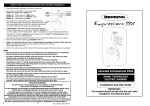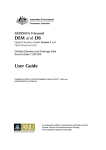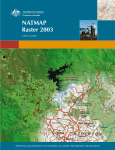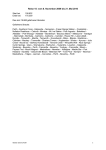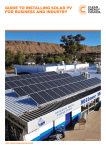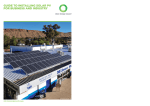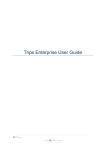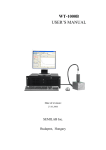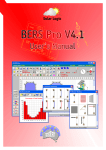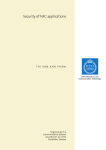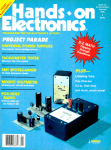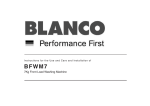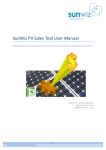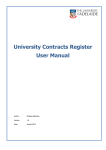Download User Guide - Mid West Development Commission
Transcript
Royalties for Regions Mid West Regional Grants Scheme User Guide Please read the Mid West Regional Grants Scheme (MWRGS) Guidelines, talk to the Mid West Development Commission and check out the Self Assessment on page 3 before starting on your application – so that you can be sure that your project is suitable for support. This User Guide should then be used alongside the Application Form and Guidelines to ensure your form is completed accurately and effectively. All documents are available from the Mid West Development Commission on the contact details below. All applicants are strongly encouraged to liaise with the Commission on their project and funding application. Feedback on a draft application form will be given if the draft is provided to us more than 2 weeks in advance of the advertised closing date. CONTESTABLE ROUND APPLICANTS Once a round has been announced, you may submit your contestable application at any time before the advertised closing date / time (see the current Application Form). Late applications will not be accepted. If successful, your project cannot begin until funding approvals are announced and a Grant Agreement is signed – please refer to the current Application Form for guidance on the earliest possible start date for your project. Mid West Development Commission Contact Details Street address: 209 Foreshore Drive, Level 2, GERALDTON WA 6530 Postal address: PO Box 238, GERALDTON WA 6531 Phone: (08) 9921 0702 E-mail: [email protected] Website: www.mwdc.wa.gov.au Page 1 of 16 TABLE OF CONTENTS SELF ASSESSMENT – SHOULD I APPLY?........................................................................................................... 3 GUIDE FOR COMPLETING THE APPLICATION FORM ....................................................................................... 4 Question 1 - General Project Information ............................................................................................................ 4 Question 2 - Organisation Details ....................................................................................................................... 4 Question 3 – Project Description ......................................................................................................................... 5 Question 4 – Statement Of Need ........................................................................................................................ 5 Question 5 – Category, Sector And Priority ........................................................................................................ 5 Question 6 – Objectives ...................................................................................................................................... 7 Question 7 – Partnerships And Local Decision Making ...................................................................................... 7 Question 8 – Project Planning And Management ............................................................................................... 8 Question 9 – Total Project Budget And Leveraged Funds ................................................................................ 10 Question 10 – Headworks .................................................................................... Error! Bookmark not defined. Question 11 – Application Checklist .................................................................................................................. 13 Question 12 – Declaration................................................................................................................................. 13 FINDING FUNDS FOR YOUR PROJECT ............................................................................................................. 14 CASH VS IN-KIND GUIDELINES .......................................................................................................................... 15 Page 2 of 16 SELF ASSESSMENT – SHOULD I APPLY? Am I an eligible applicant? MWRGS is targeted at regionally based organisations, which must be a legal entity e.g. local government, not-for-profit organisation, etc. You must have an Australian Business Number (ABN). Community / voluntary groups must be incorporated. Unincorporated organisations will need to secure an eligible auspice organisation, who will apply for the funding on your behalf and take full responsibility for the grant if successful. Organisations from outside the region may apply; however must demonstrate significant, sustainable regional benefits and a commitment to local decision-making and planning to be eligible. State and Federal Government agencies may apply, but projects deemed to be within their core business functions will not be supported. MWRGS is not intended to provide support to individuals or individual businesses. Is my project eligible? Consideration will be given to all proposals that meet the objectives of Royalties for Regions and that will deliver a positive economic, social, and/or environmental return to the Mid West. Applications from individuals or businesses are not eligible. Project expenditure must not be retrospective (i.e. already incurred before successful applicants are announced and the Grant Agreement signed). Recurrent costs once the project is complete and ongoing staff salaries are ineligible for support. Cost shifting is ineligible. A fundamental appraisal criterion is that a grant should add value by achieving something worthwhile that would not occur without grant assistance. Funding will not be approved for projects or activities that are the responsibility of another level of government. If in doubt – liaise with the Commission at your earliest opportunity. How can I make my application as competitive as possible? Remember: securing funds from MWRGS is a competitive process – your application will be assessed against the criteria in the guidelines and compared to all other applications that are received at that time. Preference will be given to projects that demonstrate that a MWRGS grant will lever cash from other sources. Priority will be given to projects that forward the goals of the Mid West Regional Blueprint. Strategic projects are highly valued – e.g. those involving partnerships, multi-use or multi-purpose facilities, supported by plans/strategies and by your local government or other agencies, etc. Legacy is highly valued – i.e. long-lasting and tangible outcomes, sustainable over the longer term. Being project ready is extremely important. Demonstrate that your project is well planned and ready to get under way with minimal delay. If you have received previous Commission funding, make sure these are all acquitted. Keep the Commission informed of the progress of your funded projects. Your track record in managing grants may influence the outcome of your application. What else can I do to improve my chance of success? Talk to the Commission at your earliest opportunity. We can help to identify: Potential partnerships or synergies with other projects (or duplication) Other possible funding sources Potential barriers to funding, or questions that the MWRGS Assessment Panel and MWDC Board are likely to have about your project How you might address any potential barriers or questions that may arise; etc. The Commission can also review a draft application and provide feedback. This can only guaranteed if we receive the draft at least two weeks before the closing date. Page 3 of 16 GUIDE FOR COMPLETING THE APPLICATION FORM If you experience any difficulties with the form, simply contact the Commission for advice and support. Writeable Adobe Acrobat (pdf) format You will need Acrobat Reader in order to read and complete the form This is available as a free download from http://get.adobe.com/reader/ Where there are tick-boxes, simply click on the correct one to select it. Where answers have a word limit, you will be unable to enter more than the specified number of words The budget will automatically calculate totals for you as you complete it. The grant request and project total amount in Q1 will appear automatically when your budget is complete. QUESTION 1 - GENERAL PROJECT INFORMATION This question allows you to tell us some basic information about your project. Project title – this should accurately describe your project and be as brief as possible. Estimated start date – the project start date will need to be after the potential commencement date noted in the guidelines (front cover). Estimated completion date – factor in that all funds need to be expended by December 2015. How will you acknowledge project funding? Do you need to allow extra time for a launch or opening event? Funds requested from MWRGS / Total cost of project / Total In-kind contribution to project / total project cost (cash + in-kind) - you do not need to enter these amounts; they will update automatically once you complete the budget section. Local Government area – list all local government areas that your project will take place in. The following are all within the Mid West region: Carnamah Chapman Valley Coorow Cue Irwin Wiluna Meekatharra Mingenew Morawa Mount Magnet Murchison Yalgoo Northampton Perenjori Sandstone Three Springs City of Greater Geraldton QUESTION 2 - ORGANISATION DETAILS This information is required to enable us to process your application and to have the correct contact details should further information be required. It is important that you complete the Organisation Details on page 3 of your application accurately to avoid delays in the assessment of your application. All applicant organisations must have an ABN. If your organisation is not incorporated and has no equivalent legal status that allows you to get an ABN, you will need to find an auspice organisation that is willing and able to apply on your behalf. If the application is successful, the auspice organisation must be willing to take full responsibility for entering into and meeting the requirements of a Grant Agreement. Where an auspice organisation is involved, it is their details that generally are required here. The only exception is that the Contact person must be the person best able to answer any questions about the development and implementation of the project, including the project budget. The full nature of the relationship between your organisation and the auspice organisation should be outlined under Question 6.1. Attach the following Copy of your ABR http://abr.business.gov.au/ record from Page 4 of 16 QUESTION 3 – PROJECT DESCRIPTION This question asks you to describe your project clearly and succinctly and helps the Commission to understand what it is that you propose to do. What do you want to do? Please be clear and concise. Focus on providing an overview of the project, including things like the aim, objectives, activities and location. Be specific about the tangible benefits i.e. a new community building. Describe the outcomes i.e. increased servicing of the community with a dedicated space for emergency service delivery. If it helps to describe the benefits and outcomes in a table please do so. HELPFUL HINT Ask someone with no involvement or knowledge of your project to read a draft answer before you finalise your application. First impressions count, and if the Assessment Panel members have trouble understanding what your project is all about, that’s not your best starting point! HELPFUL HINT If you are successful, your final acquittal report must report against your proposed outcomes and demonstrate that they have been achieved. Be wary of claiming outcomes that you will be unable to demonstrate or evidence! QUESTION 4 – STATEMENT OF NEED These question asks you to demonstrate that your project is relevant and needed in the Mid West region. This is your opportunity to provide the background to your project. Why has it been pursued and developed as a priority by your organisation? Attach the following (if applicable) Copies/extracts of relevant documents that support your statement of need (except for MWDC documents such as the Mid West Regional Blueprint). Refer to statistics, studies, reports, surveys or similar that will demonstrate the need and/or demand for the project. Pictures may also assist. HELPFUL HINT What will happen to the project if funding is not provided, will it be scaled down / postponed, will an alternative source of funding be targeted and how will this affect the community in question. Relevant, objective facts and figures that clearly demonstrate the need for your project will be your greatest allies here – be thorough in your research to uncover these! QUESTION 5 – CATEGORY, SECTOR AND PRIORITY 5.1 Which category of funding is most applicable to your project. This information is required for reporting purposes. Please tick one box only. This question is more concerned with the project itself rather than the project outcomes. Consider how the bulk of the project budget is to be spent. Infrastructure – projects involving construction or purchase of physical infrastructure such as buildings, capital items or equipment, even if the purpose of doing so is to deliver services. Services – projects that directly deliver services or information. Planning / feasibility studies or similar are also ‘services’, even if the subject of the plan or study is an infrastructure project. Page 5 of 16 5.2 Which sector of funding is most applicable to your project This information is required for reporting purposes. Please tick one box only. Choose the most appropriate sector that your project would fit within. If it does not clearly fit within any of the categories, choose the one that is the best fit. For example, an aquaculture or fisheries project should be included under ‘Agriculture’; and a sporting project may fit best under either ‘Community’ or ‘Recreational’ depending on the exact nature of the project. 5.3 Which Royalties for Regions objective is most applicable to your project This information is required for reporting purposes. Please tick one box only. Choose the most appropriate objective that your project would fit within. 5.4 Describe how the Royalties for Regions Objective selected in Q 5.3 is most applicable to your project. This question is about the tangible outcomes of your project and how they help address the Royalties for Regions objective. How will the proposed outcomes of your project help address the objective you have identified? How will you know if you have achieved these outcomes? Be specific about the tangible outcomes you expect will be delivered. Apply SMART principles to setting your targets for these, ie: Specific Measurable Attainable Relevant Time-bound 5.5 Describe how your project aligns with relevant existing regional development strategic planning. This question asks that you consult relevant documents such as the Mid West Regional Blueprint and any other regional development planning documents. The Mid West Regional Blueprint can be accessed from http://www.mwdc.wa.gov.au/blueprint.aspx. Please refer to this document for details on the elements and goals under each of the five pillars. How will the proposed outcomes of your project help address the goals and pillar your project identifies with? (http://www.mwdc.wa.gov.au/Mid%20West%20Tour ism%20Development%20Strategy.aspx). Other agencies such as Department of Planning, Tourism WA, Department of Agriculture, Department of Parks and Wildlife, etc, may also host strategic planning documents on their websites that are relevant and should be referenced. If a tourism project you may want to also refer to the the Mid West Tourism Development Strategy Page 6 of 16 QUESTION 6 – PARTNERSHIPS AND LOCAL DECISION MAKING 6.1 Provide evidence of partnerships and other support for your project by listing letters of support or equivalent documents from your project partners, local government and/or other organisations. This question asks you to specify your project partners and supporters and to attach evidence to demonstrate their support. Answering this question Tell us about two things here: any partners involved with your project and the nature of those partnerships; and support for your project from other relevant organisations or individuals. Provide letters of support or other documents to demonstrate partnerships and support. These documents must be: current to this funding round; relevant to the specific project for which funding is sought; and from organisations or individuals that are genuine partners, stakeholders and/or supporters of this project. If you are a local government applicant, you don’t need to write a letter of support for your own project. Attach the following Copies of letters of support or any other documentation demonstrating the partnerships and support you have outlined in your answer HELPFUL HINT A ‘partner’ would contribute their own cash or significant in-kind to make the project happen. A ‘stakeholder’ would benefit from the project - or could be affected by the project’s outcomes. A ‘supporter’ is any other person or organisation involved with or having an interest in the project and its outcomes. 6.2 Describe how you have involved your local government/s, the local community or others in planning and making decisions for your project. This question gives you the opportunity to outline your engagement (past and future) with relevant local stakeholders about your project. Outline the process by which you have consulted and engaged the local community (of where your project is located) in planning for your project including the relevant local government(s). You should also outline: how the local community will remain engaged throughout the life of the project, and the methods you will use to continue local decision making during the project. Attach the following (if available) Copies of reports or documents summarising any consultation you’ve undertaken. HELPFUL HINT If you’re new to working in the Mid West, the Commission can help to identify potential stakeholders within each community – another reason why you should liaise with us as early as possible! Page 7 of 16 QUESTION 7 – PROJECT PLANNING AND MANAGEMENT 7.1 To enable a grant agreement to be developed, your project must be ready for implementation in April 2015, will your project be ready by then. Simply tick the box that applies. If you select ‘no’, you should discuss with the Commission whether you should in fact apply to this funding round. All funding from this round must be expended by December 2015 and its essential that projects can be ready to be implemented once approvals are expected in approximately April 2015. If you do decide to proceed with your application, you must detail in section 8.2 what the remaining impediments to project implementation are, and the expected timeline for their resolution. 7.2 Describe the current status of the project and the action you have taken to progress it. Demonstrate that detailed project planning has been completed. This question allows you to detail the planning undertaken to date for your project and to outline any steps that still remain to be done, and the timeline for these. Applicants should demonstrate* that the project would be ready to proceed soon after funding is announced. For example, have you consulted with key stakeholders, undertaken a feasibility study, confirmed land tenure, obtained or applied for planning, environmental or any other related licences/permits or approvals? Attach the following (if applicable) Feasibility studies, reports Plans or drawings Permits, approvals, licences Evidence of land tenure Note that you will be unable to begin your project and start incurring expenditure until a Grant Agreement is signed – allow one month from the funding announcement date. If you do start before this time, your project could be ineligible for support. *Demonstrate generally means we’d expect to see documentation that illustrates or evidences your answer. For this question, that might be feasibility studies, plans or drawings, licences, permits, approvals, copies of consultation reports, etc. HELPFUL HINT 7.3 For complex projects applicants may wish to attach a separate project timeline (eg. Gantt Chart). Is a separate time-line attached? This question allows you to provide a timeline that identifies key tasks for your project. If you are successful with your application, this will be used as the basis for payment instalments of your grant. Click on the ‘yes’ or ‘no’ box, as applicable for your project. If you select ‘no’, please complete the table, outlining the key tasks / milestones for your project. Attach the following (if applicable) Gantt chart or other project timeline. HELPFUL HINT Consider and allow extra time for any potential delays that may impact on your project (eg weather, availability of contractors, final launch etc). If successful, it will be better to achieve milestones (key project achievements) ahead of schedule than behind it. Page 8 of 16 7.4 Who will manage the project and what qualifications, skills and experience do they have? This question asks you to identify the key personnel who will be involved in managing all aspects of the project, including project management, financials and reporting, and to outline their capabilities. Focus on the key people who are responsible for managing the day to day progress of the project, plus those who will be responsible for reporting. Ideally your answer will include detail of previous grants and/or similar projects each person has managed to demonstrate their experience. We expect that the contact person you’ve nominated in this application will be the primary project manager and his or her details should certainly be included here. HELPFUL HINT You will also need to provide details of the person who will be handling and signing off the financial management of the project, and the authorised officer nominated in this application. The Commission does not want a complete CV for each individual involved in the project! A brief summary of the qualifications, experience etc. of key personnel, relevant to their role in the project, will be sufficient. 7.5 Explain how your organisation will ensure the project is managed responsibly. This question allows you to demonstrate that your organisation has sufficient accountability structures and processes in place to responsibly manage a Regional Grants Scheme grant. Answering this question How do you ensure that your organisation operates legally and that all actions are authorised by the necessary people? If there are any governance peculiarities in regards to the project, such as a partnership steering group or sub-committee, you should outline the relevant reporting lines and accountability processes. You should detail your organisation’s accountability processes (eg for authorising payments), the structure of your organisation and process for approving and monitoring the implementation of projects. Attach the following (if available) Most recent audited financial statements for the organisation – having this will greatly assist us in our assessment process by helping us to understand your operations better. 7.6 Provide details of the project’s ongoing and maintenance costs and how they will be funded. This question gives you an opportunity to demonstrate the viability and sustainability of your project once the project is complete. Give details of your project’s ongoing and maintenance costs and how they will be funded. It is vital that you also outline any assumptions that underpin your figures. You may need to consider the following types of costs depending on your project: insurance utilities cleaning, maintenance & repairs staffing – especially if your project results in new positions hosting / maintenance of website or other IT outcome eg database replacement of equipment marketing and promotional activities, etc You should demonstrate that these costs can be met on an ongoing basis through your own organisation or other sources. If your project is not intended to continue beyond the funding period and therefore has no ongoing costs associated with it, (eg an event or fixed term program) please outline why this is the case. However please note that for this kind of project, it will be doubly important that you can demonstrate in question 3.2 how long-term benefits are anticipated from your project. Attach the following (if applicable) A forecast operating / maintenance budget Page 9 of 16 7.7 Has your organisation received program and/or grant funding from the State/Federal Government and/or other organisations within the last three years for similar or related projects? This question helps us to understand your previous grant-funding record, an important consideration in our assessment criteria. The Commission reserves the right to discuss your application with a third party if it is necessary to assist in assessing the application. Provide details of funding received within the last three years for similar or related projects. You should include any funds you have received from the Mid West Development Commission. If you have any grants still active with the Commission, please attach an outline of the current status of those projects and the steps that are being taken to finalise the project and acquit your grant. Attach the following (if applicable) Summary of status and way forward for any outstanding grants you have from the Mid West Development Commission HELPFUL HINT If your application is being auspiced by another organisation, this answer should provide relevant details for both organisations. QUESTION 8 – TOTAL PROJECT BUDGET AND LEVERAGED FUNDS 8.1 Does your application demonstrate a high level of financial commitment from your organisation or other sources? This question asks whether your organisation has contributed itself, and/or secured from other sources, as much money as possible for your project to keep your request of MWRGS to a minimum. For the purposes of this Scheme, a “high level of financial commitment” is defined as two thirds of the cash budget for your project being covered from sources other than MWRGS. Click on the ‘yes’ or ‘no’ box within the application form, as applicable for your project. It will automatically check for you. Recreation Facilities Fund) and you have not applied for or investigated these grants, it could result in your application being unsuccessful. If you select ‘yes’, the rest of your application should clearly demonstrate a high level of financial commitment to the project, as defined above. Preference will be given to projects that can demonstrate that a grant from this Scheme will lever funds from other sources. If you select ‘no’, clearly explain why this is the case in the space provided, eg: why your own organisation is unable to contribute any more funds to the project; all other potential funding sources you have investigated or applied for and why these are not available to you; and any action you have taken to reduce the cash cost of the project (and therefore the request of MWRGS) eg. providing or securing in-kind contributions or discounted prices. However the Commission does take into account the resources available to the applicant and the nature of the project. Even if you answer “no” in this section it doesn’t mean you won’t be successful. If your project is deemed to be suitable for another Government grant (eg a sports facility project is ideal for support from Community Sport and HELPFUL HINT At the back of this document there is a page outlining suggestions on finding contributory funds for your project, including links to a number of grant search engines. In addition, Commission staff may also be able to help in this regard, so make sure you discuss this when you liaise on your application. Page 10 of 16 8.2 Details of project items to be funded through CASH contributions. This question is about all CASH expenditure and income associated with your budget. If requesting $150,000 or more from MWRGS you must provide additional information at appendix 1. What you will need Details of the contributions by your own organisation and other parties that are secured or are being sought An estimate for auditing your complete project financials, and the name of the qualified independent auditor you will use for this (essential for all grant requests over $20,000) Quotes or estimates for significant expenditure items related to your project Please outline all of the cash expenditure you anticipate will be part of your project. All figures must exclude GST and cannot include in-kind. Cash refers to physical payments to be made to third parties. Ineligible expenditure items Retrospective expenditure i.e. any expenditure that would be incurred prior to the funding being announced and a Grant Agreement being signed. Recurrent costs once the project is completed e.g. building insurance, maintenance, operational costs, salaries, etc. Ongoing staff salaries. Employment of personnel will only be considered for a project with specific outcomes achievable with the funding provided. If in doubt please consult with a Commission staff member. Expenses that relate to cost shifting. A fundamental appraisal criterion is that a grant should add value by achieving something worthwhile that would not occur without grant assistance. Funding will not be approved for activities that are the responsibility of another level of government. Audit - the cost of an independent audit of your complete project financials must be included. Funding recognition - if successful, you will be required to provide appropriate recognition of MWRGS grant funding. This may require additional funds to be allocated for signage, plaques, opening or launch events etc. Please refer to Royalties for Regions the discuss this with the Commission to determine the level of recognition that would be appropriate for your project. Buying local and value for money - if successful, you will be requested to use products and services from the Mid West for your project wherever practicable. You will also be asked to use an open and competitive process to choose suppliers – sometimes this is set as a condition of funding. This is particularly important for large expenditure items, such as construction contracts. Be wary of creating expectations when liaising with any suppliers in developing your project budget – unless you can demonstrate that the supplier in question does offer the best value for money. Use of MWRGS funds - your budget should clearly show which items you request MWRGS funds for. Other funding sources - your budget should clearly show the name of other sources, what they will pay for and if it is approved or requested. If it is requested but not yet approved provide details of when a decision is expected. In-kind contributions - ensure any contributions deemed as in-kind are detailed in questions 8.3 rather than here. Separate guidance is provided on the different between cash and in-kind contributions at the end of this Guide. Attach the following (if applicable) Quotes and estimates to support your budget items will assist in our assessment process Written evidence that other funding outlined has been secured / confirmed. HELPFUL HINT When requesting estimates, make sure the prices will still be valid by the time you would be able to begin your project. You may wish to consider including a contingency amount to account for unexpected cost increases. Page 11 of 16 8.3 Details of project items to be funded through IN-KIND contributions. 8.4 Provide details of how all in-kind contributions have been calculated. These questions are about the in-kind contributions by your own organisation, partners or stakeholders that will reduce the cash cost of your project; you also need to outline how these contributions have been calculated and therefore would be acquitted at the end of your project if you are successful. Please outline all the in-kind contributions that will be contributed to the project. This might include your organisation’s regular staff time to manage or implement the project, voluntary labour, and discounted or donated goods and services. All in-kind contributions must exclude GST. In question 8.4 you must outline how you have calculated the value of these contributions (eg voluntary labour time = number hours by hourly rate). Please bear in mind the following guidance: Voluntary labour should be calculated at $15 per hour. Any specialised labour can be calculated at the current rate applicable to the particular trade/industry. Goods donated to the project are to be listed at their market value, ex GST. Goods or services contributed at discount rates can list the ‘difference’ as an in-kind contribution from the provider. eg John’s Whitegoods supplies a freezer for $1,500 (ex GST), the normal retail is $2,000 (ex GST). Therefore John’s Whitegoods can be listed as an in-kind contributor for an amount of $500. Please refer to the separate notes towards the end of this Guide in regards to what should be considered in-kind and what is cash. You should also discuss this with a Commission officer to be sure you include your budget expenditure items in the right sections. HELPFUL HINT If you are successful, you will need to document or record in-kind contributions as you will be required to evidence these contributions to acquit your grant. For example - timesheets for contributions of in-kind labour; invoices demonstrating discounted goods and services etc. 8.5 Please total the project (excluding GST) This will automatically updates from the figures you entered into the budget section of the application. 8.6 Audit This question is to ensure you understand the requirements for auditing of your project should you be successful, and requests that you name your auditor. An independent audit will be required for all MWRGS allocations of more than $20,000. NB an audit is not required for Community Chest Fund allocations ie maximum of $20,000 grants. Simply provide the name of the auditor engaged to undertake the financial audit for the project. The auditor must be an appropriately qualified person in this field and independent of the applicant organisation – ie not a member or employee, etc. Please note that this audit must be for the complete expenditure and income for the project - not just for the funds provided by the MWRGS. HELPFUL HINT Don’t forget to include the amount for the audit in your project budget. Page 12 of 16 QUESTION 9 – APPLICATION CHECKLIST This question is both a checklist to help you check that you have correctly completed your application and an acknowledgement that you understand the conditions and obligations that apply upon submitting your application. Please tick all boxes in this section to signify that the application form has been completed, that all required information has been attached and that you understand and accept the terms and conditions of applying for funding under this Scheme. The Commission reserves the right to request more information to clarify aspects of the application. However please note that applications that do not include the required information as described may not be competitive. QUESTION 10 – DECLARATION This section requires the signature of the person authorised to submit the application on behalf of your organisation. To be signed by the Chief Executive Officer / Chairperson or equivalent. In larger organisations, it may be that a person in a senior management role is authorised to do so. The person that signs this application should be the same person identified in question 2 as the Authorising Officer. If submitting your application by email, you should scan in or fax a copy of this page of your application with the required signed declaration. Alternatively you must indicate in your covering email that the required authority within your organisation has duly authorised the submission of this application. Page 13 of 16 FINDING FUNDS FOR YOUR PROJECT Why is this important? When assessing applications to the Mid West Regional Grants Scheme (MWRGS), leveraging of funds is an important factor – i.e. how many dollars will be contributed from other sources for each MWRGS dollar granted? Other grants schemes have a similar requirement. MWRGS is also intended to fund projects that would not happen without the support of Royalties for Regions, and is always oversubscribed. Applicants are therefore expected to demonstrate they have investigated all other options to fund the project, or to reduce the costs involved – including: other grants that may be more relevant and/or would be expected to contribute; development of partnerships to achieve the project outcomes; sponsorship or other support from private sector; fundraising; securing in-kind contributions (eg voluntary labour) to reduce costs where possible; and committing appropriate own funds to show that it’s a priority for your organisation. Where to look for grants Funding and grants availability is an ever-changing environment, but there are a few key sources of information you should start your search with, including two free guides to government grants: WA Government Grants Directory www.grantsdirectory.dlg.wa.gov.au Australia Government Grants Link www.grantslink.gov.au There are also some subscription sites that may be helpful in alerting you to grants, etc Grant Search www.grantsearch.com.au Our Community www.ourcommunity.com.au/community Some common contributory grant funders Lotterywest – supports a wide variety of not-for-profit community-based proposals. Make sure you speak to one of the Mid West-Gascoyne team members before applying: freecall 1800 655270. Steve Hammond, Michelle Beer or Mandy Grubb. www.lotterywest.wa.gov.au/grants Department of Sport and Recreation – for projects with sports and recreation focus. Talk to the Mid West Sportshouse for assistance and guidance. www.dsr.wa.gov.au/midwest Department of Culture and the Arts – for arts and cultural projects. www.dca.wa.gov.au CountryArts WA – for arts projects, specifically for regional WA. www.countryartswa.asn.au Foundation for Rural and Regional Renewal – especially suitable for small communities (e.g. population 10,000 or less) www.frrr.org.au Royalties for Regions – there are a number of other schemes or programs under Royalties for Regions that could be appropriate, including the Country Local Government Fund allocated directly to local government authorities. www.royaltiesforregions.wa.gov.au Page 14 of 16 CASH VS IN-KIND GUIDELINES This section aims to provide a guide to what should be counted as cash expenditure and what is in-kind. However it is not a substitute for discussing your project and anticipated expenditure / contributions with Commission staff, as they will be able to provide much greater assistance to you in getting your application right. As a basic principle the difference between cash and in-kind is as follows: CASH generally means external expenditure for goods or services – ie project funds are used to hire a consultant or contractor, or purchase materials or equipment for the project. IN-KIND generally means the use of existing resources, the notional value of which is allocated as both a contribution and cost to the project – eg time/expertise of existing staff members, or voluntary labour. It can also indicate donated or discounted goods or services. Below are some common project expenditure items that can be either cash or in-kind contributions depending upon the particular circumstances of each project. CASH Project management / administration – only if an external person is specifically employed to manage the project for your organisation. IN-KIND Project management / administration – more often than not this is undertaken by an existing employee of the applicant organisation in the course of their usual role and therefore can only be claimed as an in-kind May be considered if an existing part-time employee contribution by the applicant. undertakes additional hours for a fixed period, specifically for the purpose of managing the project, and this can be clearly documented. Construction (including materials and labour) – Construction – in many cases, some aspects of the generally a building contractor or company is engaged construction can be made as in-kind contributions to reduce cash costs eg volunteer labour to reduce the and therefore this is a straightforward cash expense. need for paid labourers; site works and preparation might be undertaken by LGA works crew or volunteers; donated materials. Be sure to specify the exact contribution in your budget. New equipment – usually equipment is purchased and New equipment – occasionally equipment may be therefore a straightforward cash expense. donated and is then considered an in-kind contribution. Sometimes it is offered at a discount price, and the difference between the full and discounted prices can be counted as an in-kind contribution by the supplier. Use of plant and equipment – if paying to hire plant Use of plant and equipment – if a commercial provider or project partner allows use of their plant or or equipment it is clearly a cash expense. equipment for free or at a discounted rate, then you Local government plant and equipment are considered should consider the difference between the full and in-kind contributions, unless the local government must discounted rates to be an in-kind contribution. hire plant or equipment from a third party. However, the time of any existing staff required to operate the plant or equipment is still considered to be an in-kind contribution, not cash. Page 15 of 16 CASH VS IN-KIND GUIDELINES continued CASH Travel and accommodation – sometimes required for projects that require a consultant to be engaged – if paying cash then they are clearly cash expenses. IN-KIND Travel and accommodation - in some cases travel and accommodation is covered without any actual cash expenditure - eg a corporate partner offers a seat on a charter flight to the consultant so they can get to the project site; the applicant LGA owns a vacant residence that the consultant can stay at and allows use of one of their fleet cars to the consultant for field trips (nb fuel would be considered a consumable and therefore able to be included as a cash cost). Consumables – generally expected to be a cash cost; Consumables – only likely to be in-kind if donated. be sure to demonstrate they are specific to the project in question. Audit – generally expected to be a cash cost to the Audit – in cases where an appropriately qualified applicant as it must be undertaken by an appropriately independent auditor does agree to audit financials pro qualified independent auditor. bono or at a discounted rate, then the cost of the audit (in the case of pro bono) or the difference between full and discounted cost (if done at discounted rate) should be shown as an in-kind contribution by the auditor. Calculating the value of in-kind contributions and documenting them As part of your application you need to outline how you have calculated the value of your in-kind contributions. If you are successful in your application, you will need to provide evidence to demonstrate both your cash and inkind income and expenditure to acquit your grant and receive your final instalment on project completion. Therefore it is important you consider both these aspects in preparing your budget – if you cannot see how you will be able to evidence any contribution to your project it is probably best left out of the budget. As always, if in doubt please speak with a Commission staff member for further guidance. Here are some tips for calculation and documentation of some common in-kind contributions. Item Volunteer labour Specialised labour Donated goods / services Discounted goods / services Project management / administration (in-house) Calculation $15 per person per hour is the allowable rate Use the current hourly rate applicable to the particular trade/industry Actual price to buy goods / services at full price, ex GST The difference between full and discounted price, both ex GST Usual hourly rate for staff member Documentation Timesheets Timesheets Quote / invoice / letter from supplier Quote / invoice / letter from supplier Timesheets Page 16 of 16

















